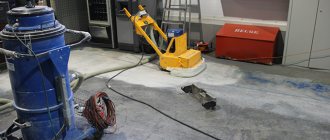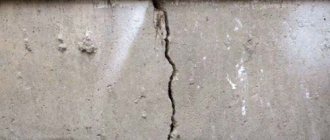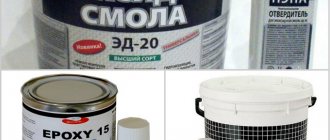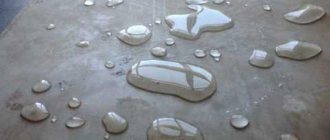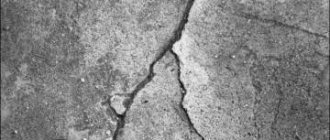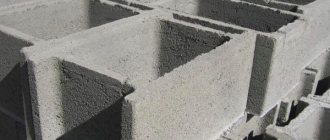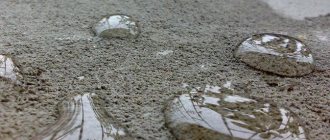FILTER
In comparison (0)
Art. 1272
Moscow and region: 2nd Irtyshsky pr., 2A, building 3 27 Availability as of 08/02/2021 Istra district, village Zakharovo, vl. 57 1 Availability as of 08/02/2021 Vidnoye, Belokamenny Highway, ow. 10 3 Availability as of 08/02/2021
Classification of repair compositions and mixtures
Repairing cracks in concrete flooring cannot be carried out without using a high-quality composition produced by specialized enterprises. This can be explained quite simply. The more effective the materials used in repairs, the higher the quality of the work performed. The use of special mixtures can ensure that the next repair is postponed for a sufficiently long time, which leads to significant cost savings. The use of dry repair mixtures will eliminate such defects as:
- shrinkage;
- the appearance of cracks;
- cavitation;
- erosion;
- wear.
What are the types of repair compounds for concrete floors?
To repair concrete floors, various repair mixtures for concrete floors are used, including:
- epoxy glue or its analogues;
- resins of different viscosity;
- high fluidity solutions;
- mixtures that harden at high speed.
Repair mixtures are divided according to their purpose:
- for repair work of load-bearing structures - beams, columns, etc.;
- for road surface repair;
- to protect structures made of concrete from corrosion.
The repair composition for concrete floors used to repair floor coverings must guarantee good adhesion to the base concrete. It is necessary to restore the load-bearing capacity, in this case, of a concrete floor. At the same time, its resistance to moisture, resistance to temperature changes and strength parameters increase. In addition, these mixtures for concrete floors should have reasonable prices. By the way, domestic and foreign practice shows that the use of repair mixtures is much more effective than the use of standard sand-cement mortars.
Floor repair in industrial premises is a topic that deserves special attention. You can get acquainted with it in more detail here.
Repair mixtures can also be divided into two large groups – thixotropic and casting. The first are necessary for repairing surfaces located in a vertical plane, the second group is used for repairing parts located in a horizontal plane. Fiber fiber is used to enhance the properties of repair mixtures.
Repair compounds
Modern repair composition for concrete is an effective protection of plaster, various masonry, and reinforcement from corrosion. Repair compounds are an indispensable assistant in the repair of various concrete structures. They are distinguished by a high level of water resistance, resistance to aggressive chemicals and repeated cycles of freezing and thawing. Repair compounds are perfect for all work on restoring the surface of concrete and reinforced concrete.
The repair and restoration composition is intended for repair, protection and waterproofing of various concrete compositions, due to the inclusion of various additives and fillers in its composition. To understand the purpose of the repair composition, it is necessary to understand that the repair of concrete or cement structure is a process aimed at restoring the structure of its surface. And the main task when carrying out these works is to determine the technology and suitable repair composition.
This choice should be justified by the following:
— area of the treated surface;
- depth and width of damage.
It should also be clearly determined whether only restoration of the concrete layer is required or whether structural repairs and general strengthening of the concrete structure are necessary. It must be borne in mind that the process of destruction of concrete is gradual and irreversible. To ensure that the building structure does not lose its strength, it is necessary to carry out timely repair work.
The concrete repair compound is also designed to protect reinforcement from corrosion and to create a durable layer between existing concrete and reinforcement.
Repair compounds have the following characteristics:
- high adhesion strength, allows you to adhere to a concrete surface without the formation of cold seams and signs of peeling of a new layer. In this case, you should pay attention to the compatibility of concrete and repair mixture;
— frost resistance, which is determined by the number of thawing and freezing cycles during the operation of the concrete structure;
— thixo-strength, which makes it possible to reduce the viscosity of the repair composition when stirring and increase it at rest;
— the included filler components in the repair composition for concrete ensure plasticity, consumption rate and bulk weight of the composition;
- waterproofness, which makes it possible to impart waterproofing properties to the finished surface.
Leveling the concrete
In addition to a set of mixtures for eliminating defects in concrete floors, it is also necessary to use the compositions necessary for leveling concrete surfaces. After these mixtures harden, a layer of material with high strength characteristics will be formed. In addition, the mixtures used to level concrete guarantee high adhesion to the base being repaired.
Manufacturers promote compositions and mixtures on the construction market designed for:
- making designer floor coverings;
- arrangement and strengthening of concrete floors located in production premises;
- installation of heavy industrial equipment.
What criteria should be used to select a composition for repairing concrete floors?
When choosing a mixture for repairing floors, you need to consider:
- type of damage;
- its size;
- operating conditions of the repaired surface.
Based on the answers to the questions posed above, it is necessary to determine what repair work needs to be performed. There are several types:
- surface strengthening;
- surface leveling;
- repair of cracks.
When strengthening the surface of a concrete floor, especially in those rooms where it bears a large load, and the floor itself does not have a solid surface (concrete screed, slabs), it is necessary to use primer compositions for repairing concrete floors, which can penetrate deep into the surface being repaired.
To repair stressed areas of the floor, it is recommended to use reinforcement. Fiber fiber is used as it. The high speed of repair work is ensured by special compounds; they harden within a few hours, as a rule, this time is 6 hours. But such mixtures have a limitation on the thickness of the applied layer. It cannot exceed 4 centimeters.
Molding mixtures are often used to level floors. They have a more liquid consistency, and this allows you to simply fill the required surface area with them. These mixtures have low shrinkage and strength. The thickness of the layer constructed from casting mixtures can reach 10 centimeters.
Leveling mixtures can also be used to perform repair work on cracks in the surface. When selecting a composition for repairing floors, it is necessary to take into account the conditions in which the concrete floor is used. If necessary, the repair mixture for concrete floors can be enriched with various substances that enhance various properties, for example, resistance to moisture.
Sealing cracks
First you need to determine the condition of the crack, whether it will go further along the coating. This can be done as follows: 1-2 months before repair, stick paper strips on it in small increments. If the paper does not tear during this time, then the crack has not grown and you can repair it.
The crack is sawed 50-60 mm deep and 20-30 mm wide using a milling machine or grinder. A Viloterm type damper cord or similar is installed. Next they are filled with special compounds based on silicone or polyurethane.
Leveling the floor
To level the floors, you need to prepare a screed of cement and sand. Before applying it, you need to thoroughly clean the floor from debris, pebbles and dust. After which you need to apply a primer. Only after it has dried can the rest of the work, in particular marking, be carried out. The height of the screed should not exceed 4 centimeters. To level floors, it is permissible to use self-leveling compounds. They can be used if there are simple defects and unevenness on the floor surface.
Long-term repair of defects
When it is necessary to restore a concrete coating with a guarantee of a long period of operation without further destruction, resin-based compositions are considered. They are characterized by good adhesion, increased strength, and do not allow cracks to increase in size. In addition, such mixtures are versatile. Another advantage of sealing cracks in concrete floors and walls using this method is the rapid drying of the composition.
Prepare tools and materials:
- containers for preparing the solution;
- spatulas;
- grinding machine, diamond-coated discs;
- vacuum cleaner;
- primer;
- resin-based composition;
- fine sand.
Sequence of actions when repairing concrete pavement:
- The crack is being repaired. At this stage, use a chisel and a hammer to remove deformed areas of the coating along the crack. The recommended leak width is 5 mm or more.
- To strengthen the coating, transverse grooves are created in this area using a grinding machine and a diamond disc. They should be located in increments of no more than 400 mm. The length of each groove is up to 150 mm. Their width corresponds to the thickness of the diamond blade.
- Use a vacuum cleaner to remove dirt and construction dust.
- The grooves are fixed using special brackets.
- The side surfaces of the crack are treated with a primer. Without this material, sufficient adhesion strength will not be ensured.
- Considering that the epoxy resin mixture hardens quickly, it is necessary to prepare it immediately before use. The composition must contain sand and a hardener, in addition to resin. The ratio of components is indicated in the mixture manufacturer's instructions.
- The crack is filled with epoxy resin. Hardening time: 10 minutes.
- When the gap is filled, sand is sprinkled on top of the mixture. It is removed before finishing work.
Epoxy resins for sealing cracks in concrete.
The best epoxy compounds
If cracks in concrete need to be filled, higher strength materials should be considered. These include:
- epoxy resin ED-16 and ED-20, the kit does not include a hardener, so it is purchased separately (price up to 500 rubles), the cost of the base material is 2000 rubles. for 3 kg of resin;
- Epoxy 520 (manufacturer Spolchemie), price 3500 rub. for 5 kg;
- UZIN KR 416 is more expensive than its analogues (RUB 2,700 per 0.75 kg), but is characterized by increased reliability and is produced in Germany.
Popular questions:
Which expanded clay is better for the floor, which fraction to choose? There is an answer from an expert
Which floor is better, concrete or wood? There is an answer from an expert
Which floor is better to make in the garage, which option is cheaper There is an answer from an expert
All questions
Sealing cracks in concrete on horizontal and vertical surfaces, concrete repair mixture
Cracks on walls can have different directions, but most often they are vertical.
We suggest you familiarize yourself with How to attach a cable duct to a concrete wall
The appearance of thin cracks less than 1 mm wide indicates that during construction in the structure or at the base of the foundation there are defects in work, errors in technology, or incorrectly selected materials.
It is necessary to conduct an analysis and carry out corrective actions on bedding, waterproofing, and additional strengthening of stone structures.
Fine cracks in concrete can be repaired with epoxy resin or liquid cement mixture. The ratio of cement and the finest sand is 1:1. Sand can be replaced with stone flour, for example, dolomite.
If you use epoxy resin, the crack must be thoroughly blown out and dried before sealing. If you use cement mortar, then first the crack must be treated with a deep penetration primer or at least moistened with water, removing dust and crumbs.
Usually thin cracks are puttied. Using the end of the tool or another thin metal plate, you need to try to “push” the solution into the depths of the crack as deeply as possible. After this, the surface is leveled with a spatula.
If the gap is large (several mm or more), in order to save money, you can add the same amount of quartz sand, fraction up to 1 mm, to the epoxy resin.
If you use a cement mixture, you can purchase ready-made cement adhesive for gluing heavy slabs or prepare the composition yourself, as was done during the construction of artificial rock and in the article about concrete tiles (how to glue concrete tiles).
This type of repair can be considered the simplest and at the same time the weakest. This is a temporary partial filling of floor, wall and foundation cracks in both dry and wet areas.
This filling of cracks does not seal them, but protects them from contamination for a while and prevents their further opening for a short time.
Repairs begin according to SNiP rules with the preparation of the opening itself.
It should be checked for chips, as other cracks and openings may form in them in the future. Use a chisel to run along the entire length of the crack to make it wider.
Next, clean the crack with water and a brush to remove various contaminants; you can also use a vacuum cleaner. Remaining water should be collected with a sponge.
Using a spatula, you should also deepen the crack to 5 mm so that the solution holds more firmly.
For repairs, make a solution of 3 parts sand and 1 part cement, to which you also need to add PVA glue. The solution should be thick enough.
Pour it into the crack with a trowel and moisten it on top. If you carry out repairs using a polymer mixture rather than using a concrete solution, you do not need to wet the composition.
In medium cracks, reinforcement is usually visible; it must be cleaned and coated with a special product that will prevent corrosion. Next, you need to make grooves and place 4 mm pieces of reinforcement in them.
Now we apply the adhesive composition evenly over the entire surface so that the layer thickness is about 3 mm, and without waiting for it to dry, you need to fill it all with the solution.
The solution must be compacted so that it gets into all the recesses and irregularities, and the surface must be leveled with a wooden strip, which must be moved along the surface of the solution to the right and left and towards you.
If the gap is very deep, it is advisable to lay the solution in several passes. At each stage, the surface should be sprayed with a little water.
A special metal trowel will help make the concrete surface perfectly smooth. When the solution has hardened, the excess must be removed with a spatula.
If you paint or cover the concrete surface with a laminate, then such work can be done within a day after the repair is made, but you should wait longer to lay the tiles.
If this does not happen, use a grinding machine to level the surface of the former crack to the desired level.
If you are dealing with a crack whose width and length are large enough, you can process it before repairing it with a circular saw with a diamond disk, after which the repair is carried out according to the scheme described above.
This method of sealing is most often used as a temporary solution, since sealing does not occur during such repairs.
The method is relevant for both dry and high-humidity rooms where good waterproofing is required.
An elastic sealant can also help seal cracks.
The most popular in this case is silicone glue - sealant. This sealant is used both for small cracks and for those whose width is quite large.
The repair process that requires the use of a sealant is no different from a repair that uses a concrete compound.
First you need to clean the crack from dirt, make grooves for better bonding of the material to the surface. When applying glue/sealant to the surface, it must also be moistened.
The sealant, unlike the cement mixture, dries in a short time, which makes this material much more convenient.
However, the sealant is noticeably more expensive, so not everyone can afford such repairs.
Epoxy resin and epoxy repair compound are also used to seal cracks in concrete.
First you need to open up the opening and remove loose concrete and chips. The width of the groove should be no more than 25 mm and no less than 4 mm.
Every 400 mm along the crack you need to make transverse grooves 150 mm long. Using a vacuum cleaner, collect all debris and dust and treat the seams with a primer.
Metal brackets for reinforcement are placed in the transverse grooves that were made earlier. Next, according to the instructions, dilute the epoxy solution and add a hardener to it.
The epoxy solution is sprinkled with sand on top, and after an hour the sand is removed with a vacuum cleaner.
Repairing a crack in concrete with epoxy resin is quite economical and takes very little time to dry. In addition, this treatment of cracks prevents their further movement.
It can be used for dry screed.
If you need to apply an epoxy resin coating to a liquid environment, you do not need to add sand to the mixture. You should also not sprinkle sand on top.
If you need to cover up cracks in a swimming pool or water tank, in an underground section of the foundation or on the external walls of a building where high-quality waterproofing is required, then the methods described above will not be enough to ensure the strength of the structure.
To treat the opening in such places, a special composition is usually used. The cost of such repairs is an order of magnitude higher than conventional methods, but in a humid environment it is completely worth it.
These materials ensure complete sealing of the crack, so the coating will last for many years.
Repairs are possible both indoors and outdoors, at any time of the year.
Repairs must begin, as in previous cases, by processing the opening. After all excess has been removed and the surface of the furrow has been cleaned with a vacuum cleaner, the width and depth are measured.
This is done in order to choose the right self-expanding cord for repair.
A cord is placed in the cut, which should lie without coercion, freely.
There should be 20-30 mm left to the bottom and top of the furrow so that the cord will expand further. Whatever type of cord you choose, you cannot force it.
Now polyurethane sealant is applied on top of the cord, the surface of which is smoothed with a spatula. The glue that has come out of the seam is removed with a sponge.
Usually it is written on the packaging which material is preferable for a given type of cord or tape; strictly follow the recommendations.
If you will use this material in relatively dry rooms, where waterproofing serves only for insurance, the finishing can be done using cement mortar.
We suggest you familiarize yourself with How to choose an electric planer for your dacha
Today the range of such products is quite wide.
This material consists of polymer resins and modified clay, and also contains bentonite material or its analogue, which binds the surfaces together and seals them.
As for the release form, they are as follows:
- Cord - the material is used for repairing shallow cracks of 30 - 50 mm;
- Tape - the material is placed in cracks 20 - 50 mm wide and up to 150 mm wide;
- Paste - sealant is used to treat small furrows;
- Mats hold together layers of concrete screed, and when the old coating is old, a new layer is laid.
The name of this method speaks for itself - injection involves introducing special materials into the voids formed in concrete by “injection”.
Injection allows you to repair concrete pavement without replacing the entire concrete pavement.
This is one of the most effective ways to repair these defects, which is also quite economical.
Injection involves introducing a cement, epoxy or polymer mixture into a crack under pressure, so that the mixture fills any small voids or cracks.
This makes the structure very strong and reliable.
This method is also used to waterproof concrete, for which different compositions are used.
